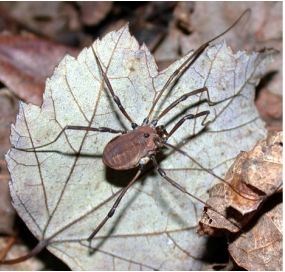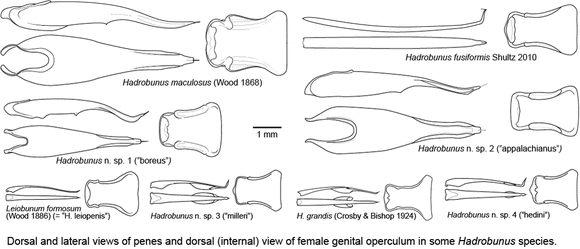Current Projects .... Page under construction

Taxonomy of endemic North American harvestmen species, especially Hadrobunus
Hadrobunus tend to be large-bodied, ground-dwelling harvestmen with relatively short legs and tiny thorn-like denticles on the dorsal surface. Until recently, the genus was thought to comprise two similar species in eastern North America (H. grandis and H. maculosus), distinguished primarily by their geographic distributions. Two additional species had been described from from Mexico (H. davisi and H. knighti). My revision of the genus has thus far revealed up to 17 species, with 15 from the eastern United States. While most species are superficially similar, the reproductive features have undergone significant diversification and sexual coevolution. In some species, the males have massive, heavily muscularized penes and females have complex and heavily sclerotized pregenital barriers. In others, the male has a short penis with a pair of gift-bear sacs and the females have little or no pregenital armature.
Hadrobunus tend to be large-bodied, ground-dwelling harvestmen with relatively short legs and tiny thorn-like denticles on the dorsal surface. Until recently, the genus was thought to comprise two similar species in eastern North America (H. grandis and H. maculosus), distinguished primarily by their geographic distributions. Two additional species had been described from from Mexico (H. davisi and H. knighti). My revision of the genus has thus far revealed up to 17 species, with 15 from the eastern United States. While most species are superficially similar, the reproductive features have undergone significant diversification and sexual coevolution. In some species, the males have massive, heavily muscularized penes and females have complex and heavily sclerotized pregenital barriers. In others, the male has a short penis with a pair of gift-bear sacs and the females have little or no pregenital armature.
Evolution of mating and reproductive morphology in the leiobunine harvestmen (daddy-longlegs) of eastern North America
The systematics of terrestrial arthropods, including the identification of species, has long depended on the unique features of genitalia and other sexually dimorphic features. In attempting to understand the systematics of harvestmen, we found many new features in both males and female harvestmen that seemed to suggest functional coevolution between the sexes. Specifically, in species where males have sclerotized penes and large clasping palps, the females have modifications of the pregential opening that would appear to resist penetration by the male. In other species, males have short, weakly sclerotized penes and penile sacs that deliver a nuptial gift and females lack any special pregenital armaments.
To understand the evolution of this system we had to determine whether do the harvestmen of eastern North America form a monophyletic group or are they an assemblage of distantly related forms;
The systematics of terrestrial arthropods, including the identification of species, has long depended on the unique features of genitalia and other sexually dimorphic features. In attempting to understand the systematics of harvestmen, we found many new features in both males and female harvestmen that seemed to suggest functional coevolution between the sexes. Specifically, in species where males have sclerotized penes and large clasping palps, the females have modifications of the pregential opening that would appear to resist penetration by the male. In other species, males have short, weakly sclerotized penes and penile sacs that deliver a nuptial gift and females lack any special pregenital armaments.
To understand the evolution of this system we had to determine whether do the harvestmen of eastern North America form a monophyletic group or are they an assemblage of distantly related forms;

